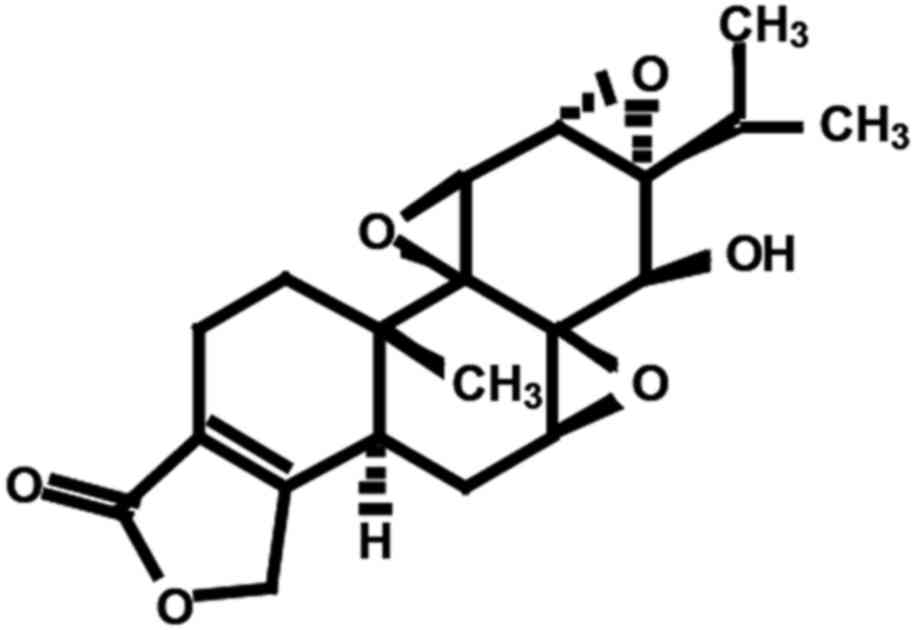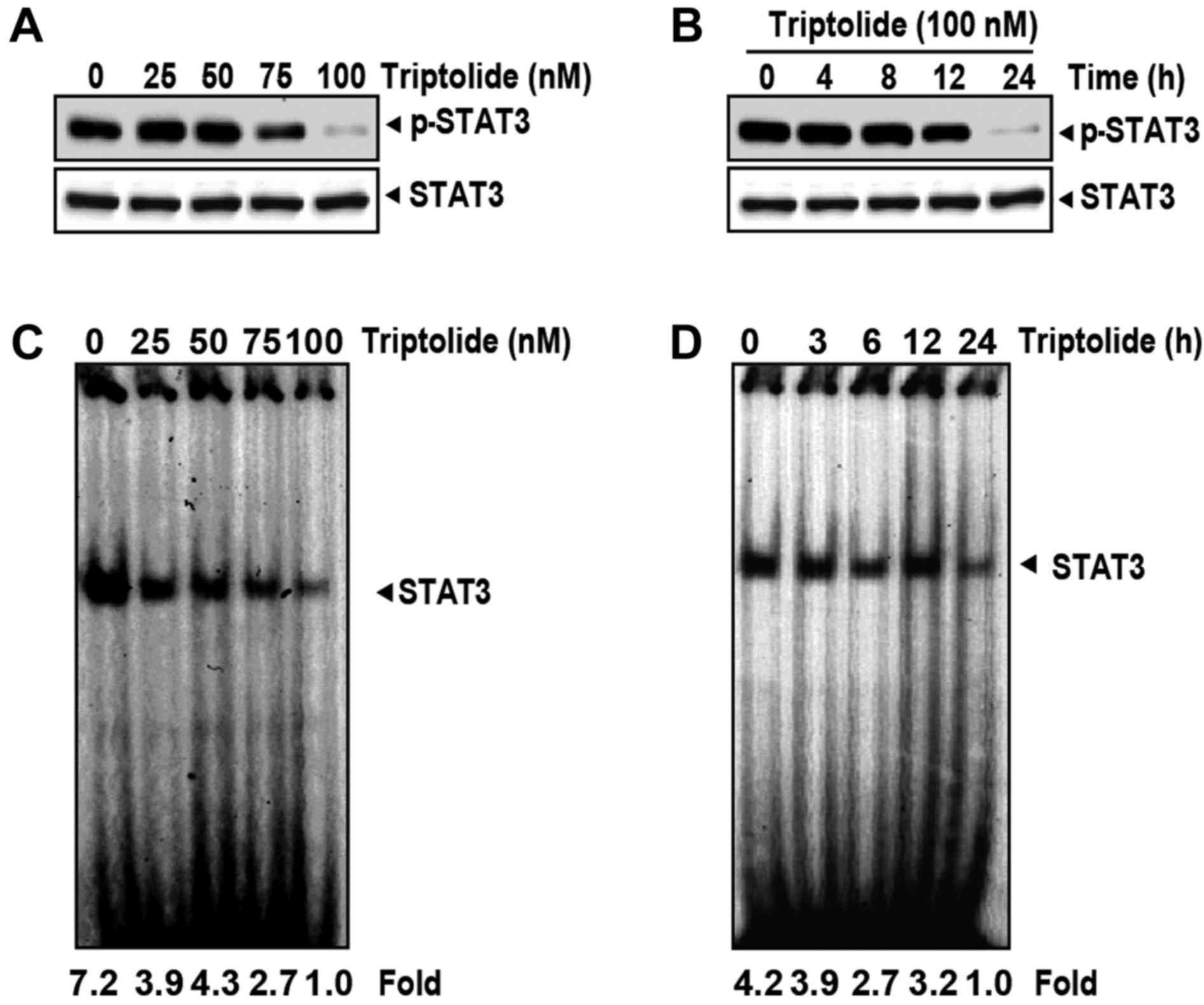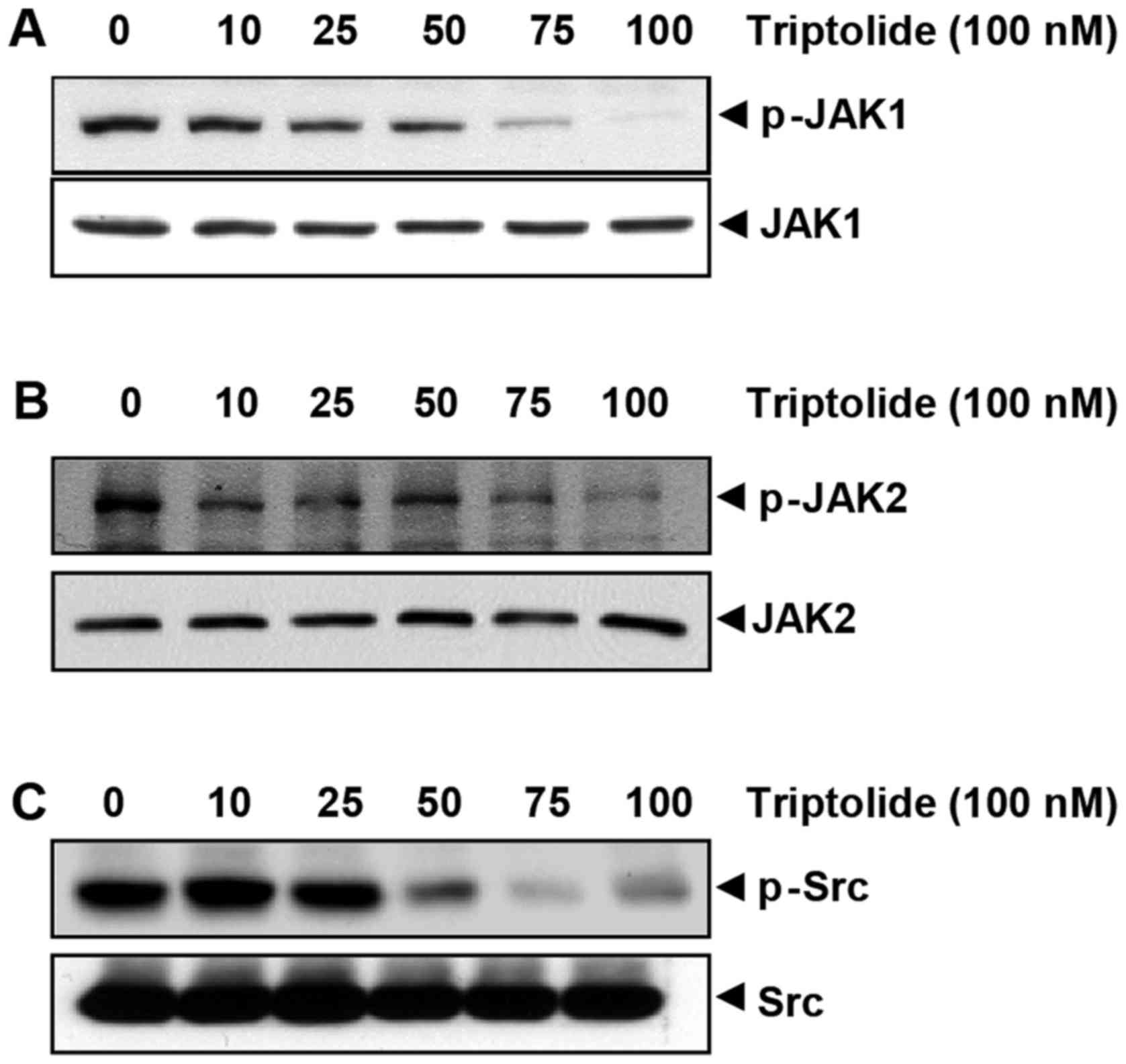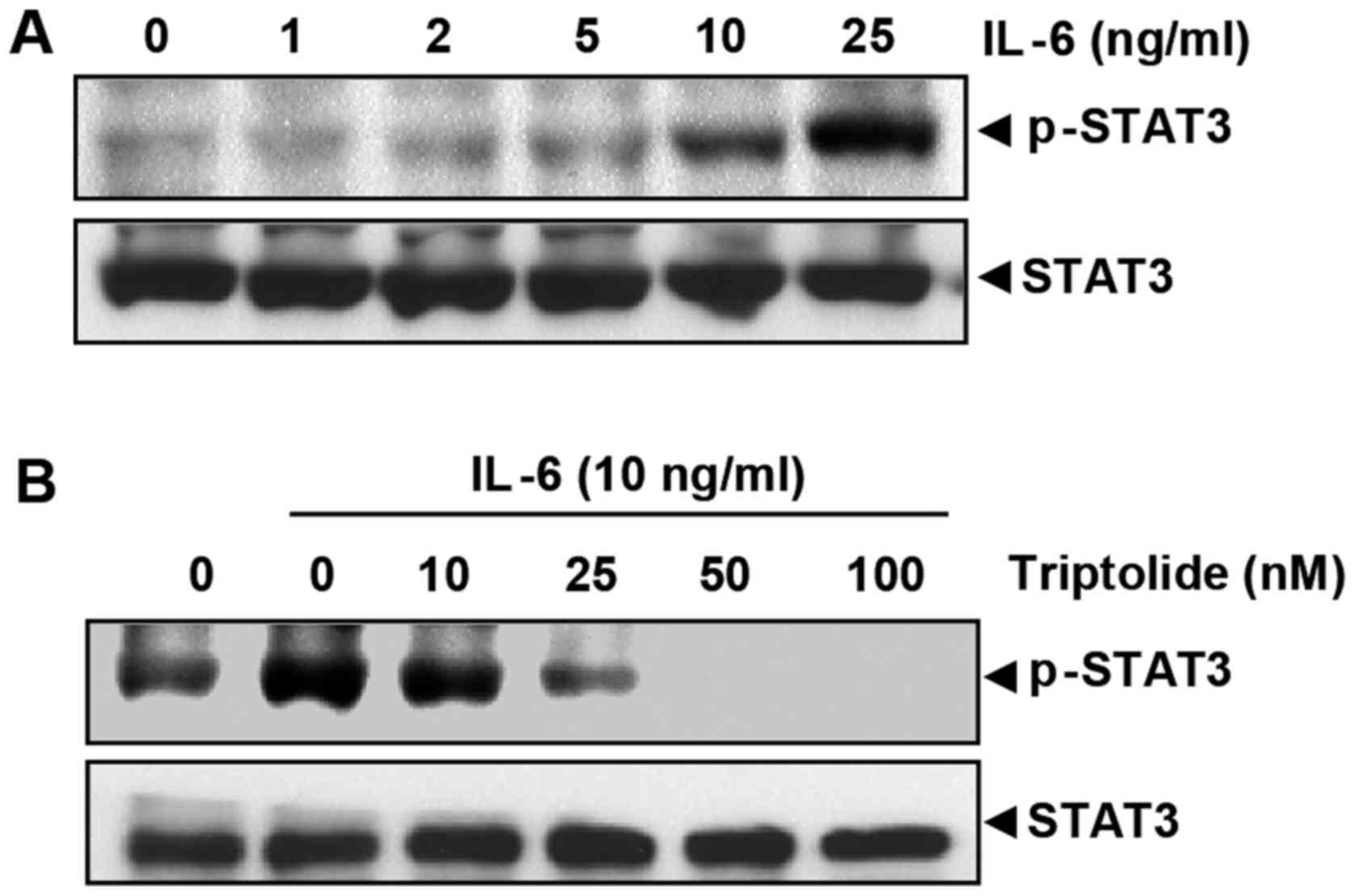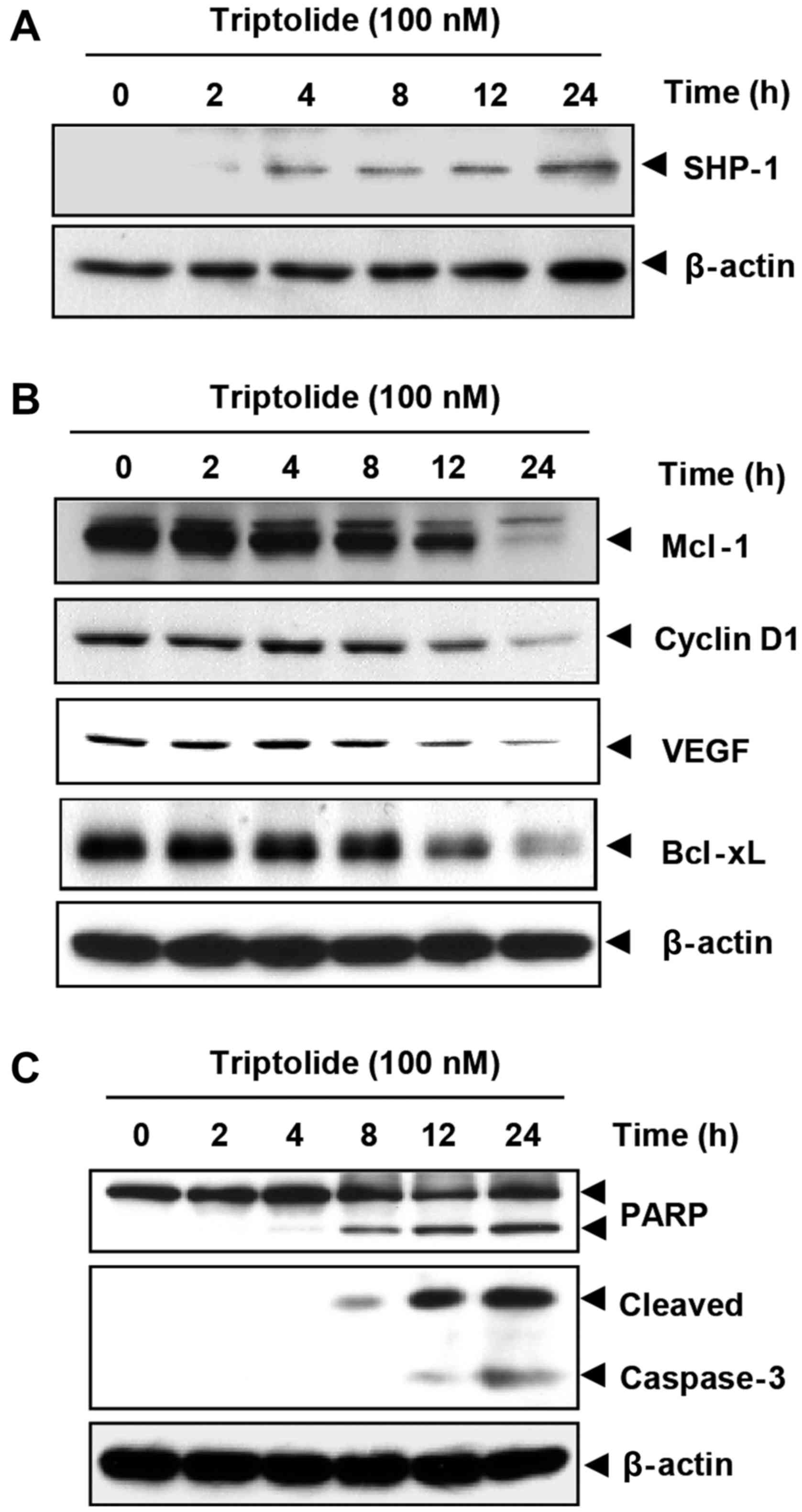Triptolide blocks the STAT3 signaling pathway through induction of protein tyrosine phosphatase SHP-1 in multiple myeloma cells
- Authors:
- Published online on: September 6, 2017 https://doi.org/10.3892/ijmm.2017.3122
- Pages: 1566-1572
Abstract
Introduction
Multiple myeloma (MM), also known as plasma cell myeloma, myelomatosis or Kahler's disease (1), is a cancer of plasma cells (the white blood cells that produce antibodies), and is considered to be incurable (2). The incidence of MM is ~4/100,000 and it accounts for 10% of all hematological malignancies (3). The treatment of MM is complex due to rapid advances in stem cell transplantation, medications and supportive care, which have improved the survival times of MM patients over the past 30 years (4). The principal treatments include stem cell (bone marrow) transplantation, non-chemotherapeutic drugs that target cancer cells, standard chemotherapeutic drugs, and corticosteroids (5). However, despite various treatment options for MM, advanced combination therapies with effective agents are required for the efficient treatment of the disease in the first-line and relapsed settings, and this has resulted in the development of novel agents (6,7).
Traditional Chinese medicine (TCM) is considered to be an important source of therapies for various diseases. In 2015, a Chinese scientist won the Nobel Prize for her work in drug development from TCM; indeed, numerous drug candidate compounds from TCM are under investigation (8). Triptolide is a diterpenoid epoxide that can be isolated from the traditional Chinese medicinal herb Tripterygium wilfordii Hook F., which is used to treat inflammatory and autoimmune diseases (9). Following the initial identification of triptolide in 1972, in vivo and in vitro experiments have revealed it to exhibit a variety of bioactivities, including immunosuppression and antiinflammatory effects (10,11). Triptolide has a complex mechanism of action, which involves inhibition of transcription factor nuclear factor κB (NF-κB) activation (12,13), suppression of the production of prostaglandin E2, and reduction of cytokine levels (13,14).
In addition to the aforementioned activities, it was recently reported that triptolide has antitumor effects in pancreatic, gastric, breast, adrenal and thyroid cancer, as well as neuroblastoma (1,15–19). Likewise, a number of studies on the effects of triptolide on various types of cancer cells, including MM, are currently underway. Although there have been numerous attempts to explain the molecular mechanisms underlying the effect of triptolide, the mechanism in MM cells remains unclear. It has been proposed that triptolide induces epigenetic alterations via the regulation of histone methylation (20), and induces apoptosis via the activation of caspases-8, -9 and -3 (cysteine proteases) in MM cells (21). However, a greater understanding of its mechanism of action in MM cells is necessary in order to develop novel anticancer drugs from triptolide, due to its potential multi-organ toxicity and narrow therapeutic window.
Notably, triptolide inhibits the Janus kinase (JAK)2 pathway in myeloproliferative disorder cells, which is a similar disease to MM (22), and it inhibits the JAK1/signal transducer and activator of transcription 3 (STAT3) and JAK2/STAT3 pathways in colon cancer cells and in a rat neuropathic pain model, respectively (23,24). STATs consist of a family of six transcription factors that regulate tumor development (25). Ligand-induced activation of cell-surface cytokine receptors activates the JAK family, which phosphorylates and activates latent cytoplasmic STAT3 protein to form an active dimer (26). Activated STAT3 translocates to the nucleus and induces transcription of STAT3-regulated genes (26). Several cytokines, including IL-6 (27), transforming growth factor-α (28) and epidermal growth factor (EGF) (27) have been shown to activate STAT3. Numerous studies have proposed that the activation of STAT3 can suppress apoptosis, and promote proliferation, angiogenesis, chemoresistance and inflammation (29–32). Thus, the STAT3 pathway must be considered to gain an understanding of oncogenesis (25). Therefore, in the present study, the effect of triptolide on MM cells via the JAK and JAK2/STAT3 pathways was investigated.
The present study aimed to investigate the effects of triptolide on the STAT3 activation pathway and the underlying mechanism in MM cells. The structure of triptolide is shown in Fig. 1. The effect of triptolide on constitutive and IL-6-induced STAT3 activation was evaluated. The effect of triptolide on STAT3-mediated gene products associated with cellular proliferation, survival and apoptosis was also investigated. Triptolide was found to suppress STAT3 activation by activating protein tyrosine phosphatase non-receptor type 6 (SHP-1), and down-regulated the expression of STAT3-regulated antiapoptotic, proliferative and angiogenic proteins.
Materials and methods
Materials
A 50-mM solution of triptolide with purity >95% was kindly provided by Dr Aggarwal at MD Anderson Cancer Center (Houston, TX, USA). Hoechst 33342, 3-(4,5-dimethylthiazol-2-yl)-2,5-diphenyltetrazolium bromide (MTT), Tris, glycine, NaCl, SDS, and bovine serum albumin (BSA) were purchased from Sigma-Aldrich (Merck Millipore, Darmstadt, Germany). RPMI-1640 medium, fetal bovine serum (FBS), 0.4% trypan blue vital stain, and antibiotic/antimycotic mixture were purchased from Invitrogen (Thermo Fisher Scientific, Inc., Waltham, MA, USA). The rabbit polyclonal anti-STAT3 antibody (#sc-482) and mouse monoclonal antibodies against phospho (p)-STAT3 (Tyr-705; #sc-8059), Bcl-xL (#sc-8392), SHP-1 (#sc-7289), cyclin D1 (#sc-753), procas-pase-3 (#sc-373730), JAK2 (#sc-278), VEGF (#sc-53462), Mcl-1 (#sc-53951) and poly(ADP-ribose) polymerase (PARP; #sc-7150) were purchased from Santa Cruz Biotechnology, Inc. (Santa Cruz, CA, USA). The horseradish peroxidase (HRP)-conjugated goat anti-rabbit antibody (#1662408) was purchased from Bio-Rad Laboratories, Inc. (Hercules, CA, USA). Antibodies against phospho-specific Src (Tyr-416; #2101S), Src (#2108), phospho-specific JAK1 (Tyr-1022/1023; #3331S), p-JAK2 (#3771S), and JAK1 (#3332) were obtained from Cell Signaling Technology, Inc. (Beverly, MA, USA). The HRP-conjugated goat anti-mouse antibody (#554002) was purchased from Transduction Laboratories (Lexington, KY, USA). Bacteria-derived recombinant human IL-6 was obtained from Novartis Pharmaceuticals (East Hanover, NJ, USA).
Cell lines
The human MM cell lines U266 and dexamethasone-sensitive MM.1S were purchased from the American Type Culture Collection (ATCC; Manassas, VA, USA). Cell lines were cultured in RPMI-1640 medium containing 10% FBS and 1X antibiotic/antimycotic solution. Cells were maintained at 37°C in an atmosphere of 5% CO2, 95% air.
Western blot analysis
For the detection of p-STAT3 (Tyr-705) and STAT3 proteins, triptolide-treated whole-cell extracts were lysed in lysis buffer [20 mM Tris (pH 7.4), 250 mM NaCl, 2 mM EDTA (pH 8.0), 0.1% Triton X-100, 0.01 mg/ml aprotinin, 0.005 mg/ml leupeptin, 0.4 mM phenylmethylsulfonyl fluoride, and 4 mM Na3VO4]. Lysates were then centrifuged at 16,025 × g for 10 min to remove insoluble material. The extracted proteins were resolved on a 7.5% SDS polyacrylamide gel. Following electrophoresis, the proteins were electrotransferred to a nitrocellulose membrane, blocked with 5% non-fat milk, and probed with anti-p-STAT3 antibodies (1:500) and anti-STAT3 antibodies (1:1,000) overnight at 4°C. The blot was then washed, exposed to HRP-conjugated secondary antibodies (1:10,000) at room temperature for 1 h, and finally examined by enhanced chemiluminescence (Amersham Biosciences, Piscataway, NJ, USA).
To detect the expression of STAT3-regulated proteins and caspase-3, U266 cells (2×106/ml) were treated with 60 μM triptolide for the indicated times. The cells were then washed and proteins were extracted by incubation for 30 min on ice in 0.05 ml of buffer containing 20 mM HEPES (pH 7.4), 2 mM EDTA, 250 mM NaCl, 0.1% Nonidet P-40, 2 μg/ml leupeptin, 2 μg/ml aprotinin, 1 mM phenylmethylsulfonyl fluoride, 0.5 μg/ml benzamidine, 1 mM DTT, and 1 mM sodium orthovanadate. The lysate was centrifuged, and the supernatant was collected. Whole-cell protein extract (50 μg) was resolved by 10% SDS-PAGE; electrotransferred onto a nitrocellulose membrane; blotted with antibodies against Bcl-xL (1:500), myeloid cell leukemia-1 (Mcl-1; 1:500), cyclin D1 (1:1,000), VEGF (1:1,000), and caspase-3 (1:1,000) overnight at 4°C. The blots were washed, exposed to HRP-conjugated goat anti-mouse antibodies for 1 h at room temperature, and then detected by enhanced chemiluminescence.
Electrophoretic mobility shift assay (EMSA)
DNA binding of STAT3 was analyzed by EMSA using a 32P-labeled high-affinity sis-inducible element probe, as previously described (33). Briefly, nuclear extracts were prepared from γ-T3-treated cells and incubated with high-affinity sis-inducible element probes (5′-CTTCATTTCCCGTAAATCCCTAAAGCT-3′ and 5′-AGCTTTAGGGATTTACGGGAAATGA-3′). The DNA-protein complexes that formed were separated from free oligonucleotides on 5% native polyacrylamide gels. The dried gels were visualized, and the radioactive bands were quantitated with a Storm 820 Phosphorimager and ImageQuant TL 7.0 (both from Amersham; GE Healthcare Life Sciences, Little Chalfont, UK).
Western blot analysis of PARP degradation
Triptolide-induced apoptosis was examined by proteolytic cleavage of PARP. Briefly, cells (2×106/ml) were treated with 60 μM triptolide for the indicated times at 37°C. The cells were then washed and subjected to protein extraction by incubation for 30 min on ice in 0.05 ml buffer containing 20 mM HEPES (pH 7.4), 2 mM EDTA, 250 mM NaCl, 0.1% Nonidet P-40, 2 ng/ml leupeptin, 2 ng/ml aprotinin, 1 mM phenylmethylsulfonyl fluoride, 0.5 ng/ml benzamidine, 1 mM DTT, and 1 mM sodium orthovanadate. The lysate was centrifuged, and the supernatant was collected. Protein extract (40 μg) was resolved by 10% SDS-PAGE, electrotransferred onto a nitrocellulose membrane, blotted with anti-PARP antibody, overnight at 4°C. The blot was washed, exposed to HRP-conjugated goat anti-mouse antibody for 1 h at room temperature, and then detected by enhanced chemiluminescence.
Results
Triptolide downregulates constitutive STAT3 activation in a dose- and time-dependent manner
Whether triptolide regulates constitutive STAT3 activation in MM cells was examined by determination of STAT3 phosphorylation. Whole-cell extracts were prepared from U266 cells pretreated for 6 h with various concentrations of triptolide and STAT3 phosphorylation was examined by western blot analysis using an anti-p-STAT3 (Tyr705) antibody. Triptolide inhibited the constitutive activation of STAT3 in U266 cells, with maximum inhibition at 100 nM (Fig. 2A). Under these conditions, triptolide had no effect on the STAT3 protein level (Fig. 2A). The incubation time required for suppression of STAT3 activation by triptolide was also examined in U266 cells. Triptolide inhibited the activation of STAT3 in a time-dependent manner, with maximum inhibition occurring at 24 h, again with no effect on the STAT3 protein level (Fig. 2B).
Triptolide inhibits DNA binding of STAT3
It was investigated whether triptolide reduces the DNA-binding activity of STAT3 based on the fact that phosphorylation of STAT3 regulates gene transcription via its dimerization, nuclear translocation and DNA binding. An EMSA using nuclear extracts of U266 cells was performed; the results indicated that triptolide decreased the DNA-binding activity of STAT3 in a dose-dependent (Fig. 2C) and time-dependent (Fig. 2D) manner. Thus, triptolide is capable of eliminating the DNA-binding ability of STAT3.
Triptolide suppresses constitutive activation of Src, JAK1, and JAK2
STAT3 may be constitutively activated by soluble tyrosine kinases of the Src kinase (34) and JAK (35) families. Therefore, the effects of triptolide on the constitutive activation of Src kinase, JAK1 and JAK2 in U266 cells were investigated. Triptolide was found to suppress the constitutive phosphorylation of JAK1 (Fig. 3A) and JAK2 (Fig. 3B) in a dose-dependent manner, while the total levels of JAK1 and JAK2 remained unchanged under the same conditions (Fig. 3A and B). As shown in Fig. 3C, triptolide suppressed the constitutive phosphorylation of Src kinase in a dose-dependent manner, while the total Src kinase protein levels remained unchanged (Fig. 3C).
Triptolide inhibits inducible STAT3 phosphorylation in MM cells
Because STAT3 is also activated by phosphorylation at tyrosine residues in response to IL-6 (27), it was investigated whether triptolide could inhibit IL-6-induced STAT3 phosphor-ylation in MM.1S cells, which lack constitutively active STAT3. As shown in Fig. 4A, IL-6 induced phosphorylation of STAT3 in a dose-dependent manner. IL-6-induced STAT3 phosphorylation was suppressed by triptolide in a dose-dependent manner (Fig. 4B). A triptolide concentration >50 nM was sufficient to suppress IL-6-induced STAT3 phosphorylation.
Triptolide induces the expression of SHP-1
SHP-1, a non-receptor-type protein tyrosine phosphatase, is known to negatively regulate the STAT3 signaling pathway (36,37). Therefore, it was examined whether the inhibition of STAT3 phosphorylation by triptolide was due to the increased expression of SHP-1. As shown in Fig. 5A, triptolide upregulated SHP-1 expression in a time-dependent manner.
Triptolide downregulates the expression of genes associated with cell survival, proliferation, and angiogenesis
The expression of the antiapoptotic proteins Mcl-1 and Bcl-xL, the cell cycle regulator protein cyclin D1, and the angiogenic protein VEGF, all of which have been reported to be regulated by STAT3 (25,38), were downregulated by triptolide treatment (Fig. 5B). Tript olide downregulated the expression of these proteins in a time-dependent manner, with maximum suppression at 24 h after the beginning of treatment (Fig. 5B).
Triptolide causes caspase-3 activation and PARP cleavage
As caspase-3 is critically involved in the regulation of antiapoptotic proteins (39) and VEGF (40), it was determined whether triptolide could activate caspase-3. Treatment of U266 cells with 100 nM triptolide induced caspase-3-dependent cleavage of a 118-kDa PARP protein into an 87-kDa fragment in a time-dependent manner (Fig. 5C).
Discussion
The Chinese herb T. wilfordii has been used for centuries as a traditional medicine for treating fever, chills and edema. Triptolide, a component extracted from T. wilfordii, has been intensively researched in recent years as it exhibits potent antitumor activity in various cancerous cells, such as human promyelocytic leukemia, T cell lymphoma, human hepatocellular carcinoma, cervical adenocarcinoma, pancreatic carcinoma, oral cancer cell and cholangiocarcinoma (41–43). However, triptolide has a serious drawback as an antitumor agent: Its toxicity (44). For this reason, the mechanism of action of triptolide in cancerous cells must be determined, as this would allow its toxicity to be reduced through chemical modification.
STAT3 is an important signaling pathway that has been associated with inflammation, survival, proliferation, chemoresistance, and angiogenesis (26). The results of the present study indicated that triptolide suppressed the phosphorylation of JAK1 and JAK2, which are upstream regulators of STAT3. Two STAT3 activation pathways were considered: i) IL-6-induced STAT3 activation via the IL-6/JAK/STAT3 cell signaling pathway, in which IL-6 binding to its receptor leads to phosphorylation of JAK, and phosphorylated JAK sequentially induces STAT3 phosphorylation; and ii) constitutive STAT3 activation involving various protein kinases (26,45,46). The IL-6/JAK/STAT3 signaling pathway serves a critical role in the growth, invasion and metastasis of cancerous cells (47). Constitutively active STAT3 is also important in the survival and proliferation of myeloma, as ~48% of MM patients have a constitutively active form of STAT3 (48). Regarding the mechanisms of STAT3 inhibition, it was observed in the present study that triptolide inhibited IL-6-induced and constitutive STAT3 activation in MM cells. It was also demonstrated that the mechanism of action of triptolide involves inhibition of induction of SHP-1, as well as activation of JAK1, JAK2 and c-Src. This is closely associated with the inhibition of the expression of various STAT3-regulated proteins and the induction of apoptosis in MM cells.
SHP-1, a negative regulator of the JAK/STAT signaling pathway, is hypermethylated in 79% of MM patients (46), and demethylation of SHP-1 decreases STAT3 activation (49). In the present study, it was demonstrated that triptolide could induce SHP-1 expression, suggesting that the induction of SHP-1 may have inhibited STAT3 activation. Abnormal methylation of suppressor of cytokine signaling 1, another regulator of the JAK/STAT3 signaling pathway, has also been observed in MM patients (50). However, this was not considered in the present study, as methylation of this gene is not strongly correlated with the clinical outcome of MM patients (50).
The present study also demonstrated that triptolide can suppress the activation of Src. Phosphorylation of Src serves a critical role in tumor cell survival. The majority of Src-transformed cell lines have persistently activated STAT3 and dominant-negative STAT3 blocks transformation (51). Furthermore, constitutive STAT3 activation has been implicated in the increased resistance to apoptosis, which leads to radiation resistance and chemoresistance (51). This may be mediated by the expression of the STAT3-regulated gene products including Bcl-xL, Mcl-1, and cyclin D1. Antiapoptotic proteins such as Bcl-xL and Mcl-1 inhibit the induction of cell death by various chemotherapeutic drugs, in parallel with an increase in chemoresistance (52). The present study demonstrated that triptolide downregulated Bcl-xL, Mcl-1 and cyclin D1, which implies that the suppression of STAT3 activation by triptolide may facilitate the apoptosis of MM cells. It was also found that triptolide downregulated the expression of VEGF, which is involved in angiogenesis of cancer cells, suggesting that triptolide may exert an antiangiogenic effect by downregulating VEGF.
Triptolide was previously reported to inhibit the transcription factor, NF-κB (21). However, it is unclear whether the inhibition of NF-κB activation is linked to the inhibition of STAT3 activation by triptolide. NF-κB and STAT3 are activated by different cytokines; for example, tumor necrosis factor is a major activator of NF-κB, whereas IL-6 activates STAT3. However, notably, JAK activation has been reported to regulate both STAT3 and NF-κB activation (53). Therefore, triptolide is a potent chemotherapeutic agent targeting JAK regulation, which regulates NF-κB and STAT3 activation.
Triptolide has been widely used in East Asia for centuries for the treatment of inflammatory and autoimmune diseases, and the antitumor activity of triptolide has been investigated in various cancer cell types. The present study demonstrated that triptolide inhibits both inducible and constitutive STAT3 activation in MM cells, suggesting that it suppresses tumor cell survival, proliferation and angiogenesis. Although several barriers to the clinical use of triptolide remain to be overcome, further development of triptolide derivatives and clinical studies may result in the development of novel anticancer agents.
Acknowledgments
This study was supported by the Basic Science Research Program through the National Research Foundation of Korea (NRF), funded by the Ministry of Education (grant no. NRF-2016R1A6A1A03011325)
Glossary
Abbreviations
Abbreviations:
|
STAT3 |
signal transducer and activator of transcription 3 |
|
JAK |
Janus kinase |
|
SHP-1 |
protein tyrosine phosphatase non-receptor type 6 |
|
Mcl-1 |
myeloid cell leukemia-1 |
|
VEGF |
vascular endothelial growth factor |
|
IL-6 |
interleukin-6 |
|
PARP |
poly(ADP-ribose) polymerase |
|
MM |
multiple myeloma |
References
|
Yang S, Chen J, Guo Z, Xu XM, Wang L, Pei XF, Yang J, Underhill CB and Zhang L: Triptolide inhibits the growth and metastasis of solid tumors. Mol Cancer Ther. 2:65–72. 2003.PubMed/NCBI | |
|
Raab MS, Podar K, Breitkreutz I, Richardson PG and Anderson KC: Multiple myeloma. Lancet. 374:324–339. 2009. View Article : Google Scholar : PubMed/NCBI | |
|
Jemal A, Siegel R, Xu J and Ward E: Cancer statistics, 2010. CA Cancer J Clin. 60:277–300. 2010. View Article : Google Scholar : PubMed/NCBI | |
|
Kumar SK, Dispenzieri A, Lacy MQ, Gertz MA, Buadi FK, Pandey S, Kapoor P, Dingli D, Hayman SR, Leung N, et al: Continued improvement in survival in multiple myeloma: changes in early mortality and outcomes in older patients. Leukemia. 28:1122–1128. 2014. View Article : Google Scholar : | |
|
Kyle RA and Rajkumar SV: Treatment of multiple myeloma: a comprehensive review. Clin Lymphoma Myeloma. 9:278–288. 2009. View Article : Google Scholar : PubMed/NCBI | |
|
Kyle RA: Targeted therapy of multiple myeloma. Hematology. 17(Suppl 1): 125–128. 2012. | |
|
Anderson KC: The 39th David A. Karnofsky Lecture: bench-to- bedside translation of targeted therapies in multiple myeloma. J Clin Oncol. 30:445–452. 2012. View Article : Google Scholar : PubMed/NCBI | |
|
Kong LY and Tan RX: Artemisinin, a miracle of traditional Chinese medicine. Nat Prod Rep. 32:1617–1621. 2015. View Article : Google Scholar : PubMed/NCBI | |
|
Ding GS: Important Chinese herbal remedies. Clin Ther. 9:345–357. 1987.PubMed/NCBI | |
|
Chen BJ: Triptolide, a novel immunosuppressive and anti-inflammatory agent purified from a Chinese herb Tripterygium wilfordii Hook F. Leuk Lymphoma. 42:253–265. 2001. View Article : Google Scholar : PubMed/NCBI | |
|
Wu R, Li Y, Guo Z, Gong J, Zhu W, Li N and Li J: Triptolide ameliorates ileocolonic anastomosis inflammation in IL-10 deficient mice by mechanism involving suppression of miR-155/SHIP-1 signaling pathway. Mol Immunol. 56:340–346. 2013. View Article : Google Scholar : PubMed/NCBI | |
|
Wei X, Gong J, Zhu J, Wang P, Li N, Zhu W and Li J: The suppressive effect of triptolide on chronic colitis and TNF-alpha/TNFR2 signal pathway in interleukin-10 deficient mice. Clin Immunol. 129:211–218. 2008. View Article : Google Scholar : PubMed/NCBI | |
|
Qiu D and Kao PN: Immunosuppressive and anti-inflammatory mechanisms of triptolide, the principal active diterpenoid from the Chinese medicinal herb Tripterygium wilfordii Hook. f. Drugs R D. 4:1–18. 2003. View Article : Google Scholar : PubMed/NCBI | |
|
Lin N, Liu C, Xiao C, Jia H, Imada K, Wu H and Ito A: Triptolide, a diterpenoid triepoxide, suppresses inflammation and cartilage destruction in collagen-induced arthritis mice. Biochem Pharmacol. 73:136–146. 2007. View Article : Google Scholar | |
|
Zhu W, He S, Li Y, Qiu P, Shu M, Ou Y, Zhou Y, Leng T, Xie J, Zheng X, et al: Anti-angiogenic activity of triptolide in anaplastic thyroid carcinoma is mediated by targeting vascular endothelial and tumor cells. Vascul Pharmacol. 52:46–54. 2010. View Article : Google Scholar | |
|
Banerjee S, Sangwan V, McGinn O, Chugh R, Dudeja V, Vickers SM and Saluja AK: Triptolide-induced cell death in pancreatic cancer is mediated by O-GlcNAc modification of transcription factor Sp1. J Biol Chem. 288:33927–33938. 2013. View Article : Google Scholar : PubMed/NCBI | |
|
Phillips PA, Dudeja V, McCarroll JA, Borja-Cacho D, Dawra RK, Grizzle WE, Vickers SM and Saluja AK: Triptolide induces pancreatic cancer cell death via inhibition of heat shock protein 70. Cancer Res. 67:9407–9416. 2007. View Article : Google Scholar : PubMed/NCBI | |
|
Wu PP, Liu KC, Huang WW, Ma CY, Lin H, Yang JS and Chung JG: Triptolide induces apoptosis in human adrenal cancer NCI-H295 cells through a mitochondrial-dependent pathway. Oncol Rep. 25:551–557. 2011. | |
|
Zheng Y, Zhang WJ and Wang XM: Triptolide with potential medicinal value for diseases of the central nervous system. CNS Neurosci Ther. 19:76–82. 2013. View Article : Google Scholar | |
|
Zhao F, Chen Y, Li R, Liu Y, Wen L and Zhang C: Triptolide alters histone H3K9 and H3K27 methylation state and induces G0/G1 arrest and caspase-dependent apoptosis in multiple myeloma in vitro. Toxicology. 267:70–79. 2010. View Article : Google Scholar | |
|
Yinjun L, Jie J and Yungui W: Triptolide inhibits transcription factor NF-kappaB and induces apoptosis of multiple myeloma cells. Leuk Res. 29:99–105. 2005. View Article : Google Scholar | |
|
Chen Q, Lu Z, Jin Y, Wu Y and Pan J: Triptolide inhibits Jak2 transcription and induces apoptosis in human myeloproliferative disorder cells bearing Jak2V617F through caspase-3-mediated cleavage of Mcl-1. Cancer Lett. 291:246–255. 2010. View Article : Google Scholar | |
|
Tang J, Li ZH, Ge SN, Wang W, Mei XP, Wang W, Zhang T, Xu LX and Li JL: The inhibition of spinal astrocytic JAK2-STAT3 pathway activation correlates with the analgesic effects of triptolide in the rat neuropathic pain model. Evid Based Complement Alternat Med. 2012:1851672012. View Article : Google Scholar | |
|
Wang Z, Jin H, Xu R, Mei Q and Fan D: Triptolide downregulates Rac1 and the JAK/STAT3 pathway and inhibits colitis-related colon cancer progression. Exp Mol Med. 41:717–727. 2009. View Article : Google Scholar : PubMed/NCBI | |
|
Aggarwal BB, Sethi G, Ahn KS, Sandur SK, Pandey MK, Kunnumakkara AB, Sung B and Ichikawa H: Targeting signal -transducer-and-activator-of-transcription-3 for prevention and therapy of cancer: modern target but ancient solution. Ann N Y Acad Sci. 1091:151–169. 2006. View Article : Google Scholar | |
|
Yu H, Kortylewski M and Pardoll D: Crosstalk between cancer and immune cells: role of STAT3 in the tumour microenvironment. Nat Rev Immunol. 7:41–51. 2007. View Article : Google Scholar | |
|
Zhong Z, Wen Z and Darnell JE Jr: Stat3: a STAT family member activated by tyrosine phosphorylation in response to epidermal growth factor and interleukin-6. Science. 264:95–98. 1994. View Article : Google Scholar : PubMed/NCBI | |
|
Grandis JR, Drenning SD, Chakraborty A, Zhou MY, Zeng Q, Pitt AS and Tweardy DJ: Requirement of Stat3 but not Stat1 activation for epidermal growth factor receptor-mediated cell growth in vitro. J Clin Invest. 102:1385–1392. 1998. View Article : Google Scholar : PubMed/NCBI | |
|
Zushi S, Shinomura Y, Kiyohara T, Miyazaki Y, Kondo S, Sugimachi M, Higashimoto Y, Kanayama S and Matsuzawa Y: STAT3 mediates the survival signal in oncogenic ras-transfected intestinal epithelial cells. Int J Cancer. 78:326–330. 1998. View Article : Google Scholar : PubMed/NCBI | |
|
Shen Y, Devgan G, Darnell JE Jr and Bromberg JF: Consti tutively activated Stat3 protects fibroblasts from serum withdrawal and UV-induced apoptosis and antagonizes the proapoptotic effects of activated Stat1. Proc Natl Acad Sci USA. 98:1543–1548. 2001. View Article : Google Scholar | |
|
Bhattacharya S, Ray RM and Johnson LR: STAT3-mediated transcription of Bcl-2, Mcl-1 and c-IAP2 prevents apoptosis in polyamine-depleted cells. Biochem J. 392:335–344. 2005. View Article : Google Scholar : PubMed/NCBI | |
|
Aoki Y, Feldman GM and Tosato G: Inhibition of STAT3 signaling induces apoptosis and decreases survivin expression in primary effusion lymphoma. Blood. 101:1535–1542. 2003. View Article : Google Scholar | |
|
Yu CL, Meyer DJ, Campbell GS, Larner AC, Carter-Su C, Schwartz J and Jove R: Enhanced DNA-binding activity of a Stat3-related protein in cells transformed by the Src oncoprotein. Science. 269:81–83. 1995. View Article : Google Scholar : PubMed/NCBI | |
|
Schreiner SJ, Schiavone AP and Smithgall TE: Activation of STAT3 by the Src family kinase Hck requires a functional SH3 domain. J Biol Chem. 277:45680–45687. 2002. View Article : Google Scholar : PubMed/NCBI | |
|
Ihle JN: STATs: signal transducers and activators of transcription. Cell. 84:331–334. 1996. View Article : Google Scholar : PubMed/NCBI | |
|
Chim CS, Fung TK, Cheung WC, Liang R and Kwong YL: SOCS1 and SHP1 hypermethylation in multiple myeloma: implications for epigenetic activation of the Jak/STAT pathway. Blood. 103:4630–4635. 2004. View Article : Google Scholar : PubMed/NCBI | |
|
Oka T, Ouchida M, Koyama M, Ogama Y, Takada S, Nakatani Y, Tanaka T, Yoshino T, Hayashi K, Ohara N, et al: Gene silencing of the tyrosine phosphatase SHP1 gene by aberrant methylation in leukemias/lymphomas. Cancer Res. 62:6390–6394. 2002.PubMed/NCBI | |
|
Yu H and Jove R: The STATs of cancer - new molecular targets come of age. Nat Rev Cancer. 4:97–105. 2004. View Article : Google Scholar : PubMed/NCBI | |
|
Weinmann P, Gaehtgens P and Walzog B: Bcl-Xl- and Bax-alpha-mediated regulation of apoptosis of human neutrophils via caspase-3. Blood. 93:3106–3115. 1999.PubMed/NCBI | |
|
Jin K, Mao XO, Batteur SP, McEachron E, Leahy A and Greenberg DA: Caspase-3 and the regulation of hypoxic neuronal death by vascular endothelial growth factor. Neuroscience. 108:351–358. 2001. View Article : Google Scholar : PubMed/NCBI | |
|
Chan EW, Cheng SC, Sin FW and Xie Y: Triptolide induced cytotoxic effects on human promyelocytic leukemia, T cell lymphoma and human hepatocellular carcinoma cell lines. Toxicol Lett. 122:81–87. 2001. View Article : Google Scholar : PubMed/NCBI | |
|
Chen YW, Lin GJ, Chia WT, Lin CK, Chuang YP and Sytwu HK: Triptolide exerts anti-tumor effect on oral cancer and KB cells in vitro and in vivo. Oral Oncol. 45:562–568. 2009. View Article : Google Scholar : PubMed/NCBI | |
|
Tengchaisri T, Chawengkirttikul R, Rachaphaew N, Reutrakul V, Sangsuwan R and Sirisinha S: Antitumor activity of triptolide against cholangiocarcinoma growth in vitro and in hamsters. Cancer Lett. 133:169–175. 1998. View Article : Google Scholar | |
|
Pyatt DW, Yang Y, Mehos B, Le A, Stillman W and Irons RD: Hematotoxicity of the chinese herbal medicine Tripterygium wilfordii Hook f in CD34-positive human bone marrow cells. Mol Pharmacol. 57:512–518. 2000.PubMed/NCBI | |
|
Schindler C and Darnell JE Jr: Transcriptional responses to polypeptide ligands: the JAK-STAT pathway. Annu Rev Biochem. 64:621–651. 1995. View Article : Google Scholar : PubMed/NCBI | |
|
Hodge DR, Hurt EM and Farrar WL: The role of IL-6 and STAT3 in inflammation and cancer. Eur J Cancer. 41:2502–2512. 2005. View Article : Google Scholar : PubMed/NCBI | |
|
Chang Q, Bournazou E, Sansone P, Berishaj M, Gao SP, Daly L, Wels J, Theilen T, Granitto S, Zhang X, et al: The IL-6/JAK/Stat3 feed-forward loop drives tumorigenesis and metastasis. Neoplasia. 15:848–862. 2013. View Article : Google Scholar : PubMed/NCBI | |
|
Quintanilla-Martinez L, Kremer M, Specht K, Calzada-Wack J, Nathrath M, Schaich R, Höfler H and Fend F: Analysis of signal transducer and activator of transcription 3 (Stat 3) pathway in multiple myeloma: Stat 3 activation and cyclin D1 dysregulation are mutually exclusive events. Am J Pathol. 162:1449–1461. 2003. View Article : Google Scholar : PubMed/NCBI | |
|
Zhang Q, Raghunath PN, Vonderheid E, Odum N and Wasik MA: Lack of phosphotyrosine phosphatase SHP-1 expression in malignant T-cell lymphoma cells results from methylation of the SHP-1 promoter. Am J Pathol. 157:1137–1146. 2000. View Article : Google Scholar : PubMed/NCBI | |
|
Depil S, Saudemont A and Quesnel B: SOCS-1 gene methylation is frequent but does not appear to have prognostic value in patients with multiple myeloma. Leukemia. 17:1678–1679. 2003. View Article : Google Scholar : PubMed/NCBI | |
|
Catlett-Falcone R, Landowski TH, Oshiro MM, Turkson J, Levitzki A, Savino R, Ciliberto G, Moscinski L, Fernández-Luna JL, Nuñez G, et al: Constitutive activation of Stat3 signaling confers resistance to apoptosis in human U266 myeloma cells. Immunity. 10:105–115. 1999. View Article : Google Scholar : PubMed/NCBI | |
|
Heere-Ress E, Thallinger C, Lucas T, Schlagbauer-Wadl H, Wacheck V, Monia BP, Wolff K, Pehamberger H and Jansen B: Bcl-X(L) is a chemoresistance factor in human melanoma cells that can be inhibited by antisense therapy. Int J Cancer. 99:29–34. 2002. View Article : Google Scholar : PubMed/NCBI | |
|
Digicaylioglu M and Lipton SA: Erythropoietin-mediated neuro-protection involves cross-talk between Jak2 and NF-kappaB signalling cascades. Nature. 412:641–647. 2001. View Article : Google Scholar : PubMed/NCBI |



